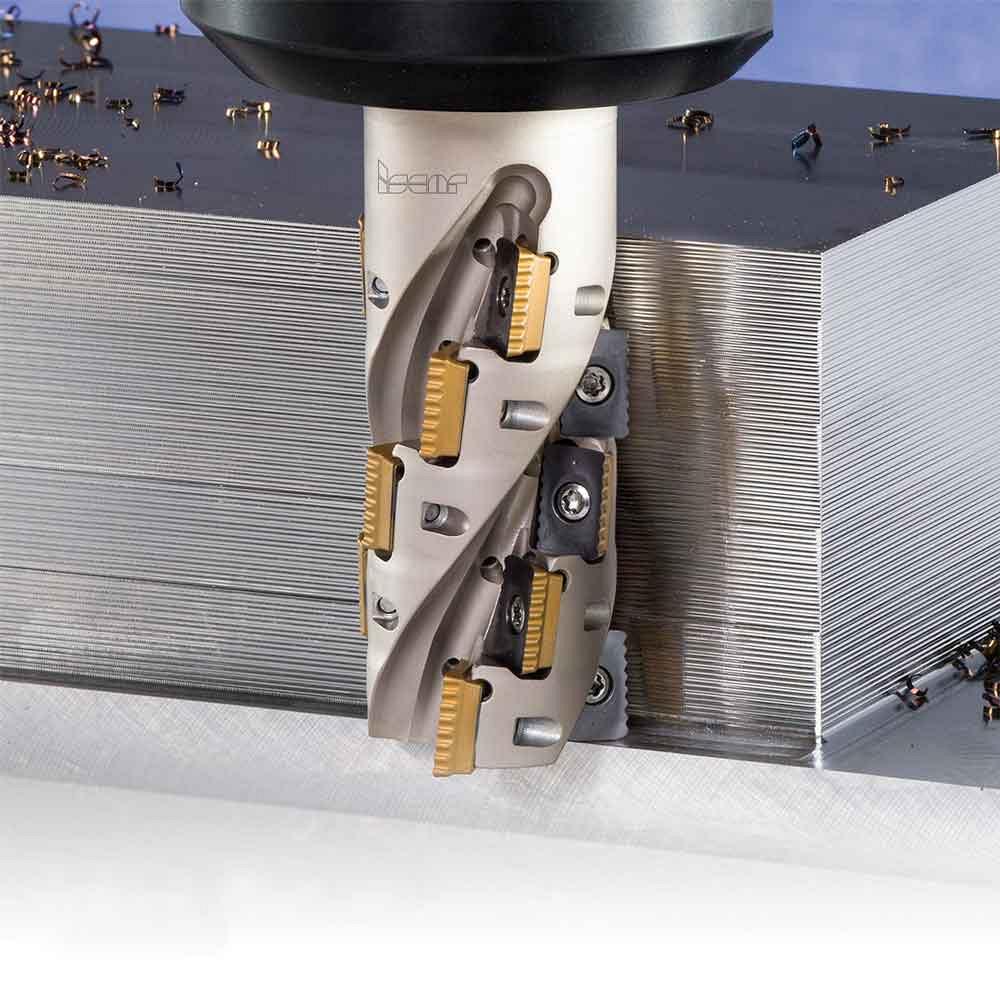Technical Advisor
- FMA
- The Fabricator
- FABTECH
- Canadian Metalworking
Extended-flute cutters extend milling efficiency
New technology improves chip removal by shredding chips
- By Andrei Petrilin
- September 28, 2016

The MillShred P290 features radially clamped inserts, increasing the chip gullet’s volume and, therefore, improving chip evacuation.
Indexable extended-flute (sometimes referred to as long-edge, porcupine, and even porky) cutters are universally regarded as the ideal tools for high-performance rough milling, when a machining allowance per pass is significant.
For milling deep shoulders, cavities, and pockets or wide edges (edging), indexable milling cutters help to ensure suitable results. The use of extended-flute cutters is common across numerous heavy-duty operations in manufacturing sectors such as general engineering, railway, aerospace, and die and mould.
The ever-increasing demand to continuously improve productivity has prompted the further development of these porcupines to create the required efficiencies.
Split Chips
Extended-flute cutters are placed under significant load when they remove a large material layer, and their work in such heavy-cutting conditions is characterized by high cutting forces, considerable power consumption, and substantial heat generation.
Intensive material removal requires the use of a cutter with a chip gullet of considerable volume to ensure effective chip evacuation. This decreases the number of the cutter’s flutes (effective teeth), reducing its productivity. In addition, high cutting forces acting cyclically induce serious vibrations. When using indexable inserts that have a chip splitting action, it is possible to avoid these difficulties.
Inserts featuring chip splitters have a geometry that enables the division of a wide chip into small segments.
As a result, cutting forces and power consumption are reduced, vibration is stabilized, and thermal problems are eased.
Inserts with serrated, wavy cutting edges provide efficient machining with a chip splitting (even chip crushing) action. For optimal chip crushing, it is recommended that users mount the inserts in alternative edge configurations on adjacent flutes of the tool. However, even if the inserts are mounted randomly, the tool will continue to mill effectively.
Tangential clamping creates two important advantages within the tool design. First, it enables effective use of the insert’s cross section to enable it to resist heavy loads. Second, this approach ensures strength and rigidity in the tool body.
Radial Clamping
Other extended-flute cutters, such as Iscar’s MillShred P290 (shown here), adheres to the more common concept of clamping inserts radially. Under equal conditions, radial clamping may demonstrate less strength-related properties when compared to tangential clamping; however, radial clamping makes it possible to increase the chip gullets volume and, in doing so, significantly improves chip evacuation.
Not Only a Square Shoulder
The majority of extended-flute milling tools have 90-degree cutting edge angles and are designed to machine straight edges and square shoulders or slots. Although various manufacturing processes require productive roughing for inclined or 3-D surfaces, in these cases the extended flute can be a suitable means of improving efficiency.
Tapered tools with cutting edge angles from 22.5 to 75 degrees also are now available for heavy-duty machining applications.
Certain extended-flute ball nose end mills are now designed specifically for efficient profile and shoulder milling, mainly within the die and mould industry. These end mills carry straight-edge inserts that enable machining beyond the spherical (ball nose) cutting edge, which is generated by teardrop inserts. The design of the latter successfully adopted the chip splitting approach.
Milling High-temperature Alloys
The milling of titanium and high-temperature alloys places very specific requirements on extended-flute cutters.
In these cases, internal channels that deliver a sufficient coolant supply, directly through the body of a cutter, are absolutely necessary. Milling with high-pressure coolant (HPC) or with cryogenic coolant has its own distinctive requirements that should be taken into consideration when designing cutters. These demands result in the availability of various tailor-made tools.
However, even standard families of extended-flute cutters are suitable for milling the difficult-to-cut materials associated with the aerospace industry.
It should be noted that extended-flute cutters differ in their types and design configurations and have strong performance potential. If they are applied in the right, intelligent way, they can extend the frontier of indexable milling efficiency.
Andrei Petrilin is technical manager of indexable milling for Iscar Tools, 905-829-9000, www.iscar.ca.
subscribe now


Keep up to date with the latest news, events, and technology for all things metal from our pair of monthly magazines written specifically for Canadian manufacturers!
Start Your Free SubscriptionAbout the Author
Andrei Petrilin
2100 Bristol Circle
Oakville, L6H 5R3 Canada
905-829-9000
- Industry Events
MME Winnipeg
- April 30, 2024
- Winnipeg, ON Canada
CTMA Economic Uncertainty: Helping You Navigate Windsor Seminar
- April 30, 2024
- Windsor, ON Canada
CTMA Economic Uncertainty: Helping You Navigate Kitchener Seminar
- May 2, 2024
- Kitchener, ON Canada
Automate 2024
- May 6 - 9, 2024
- Chicago, IL
ANCA Open House
- May 7 - 8, 2024
- Wixom, MI




















